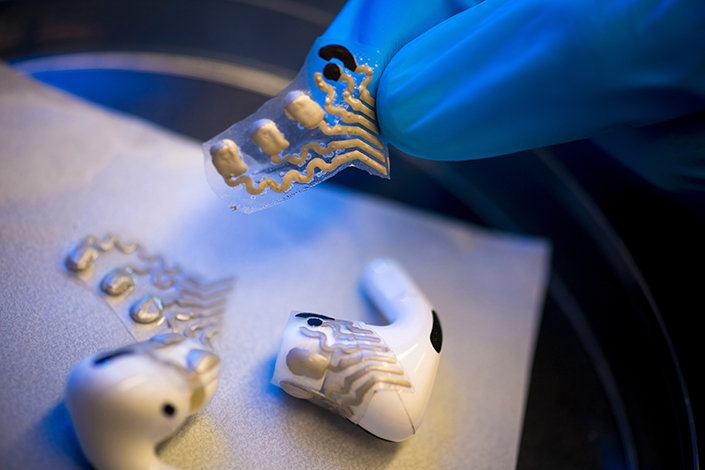UC San Diego engineering researchers have developed flexible sensor screens that can be attached to earbuds to record electrical activity in the brain and measure exercise levels within the ear.
The team of researchers published their creation in the Nature Biomedical Engineering journal in late September, including information on various studies to test the sensitivity, accuracy, and longevity of the wearable technology, described as an “integrated sensor array for the continuous monitoring of brain activity and of lactate in sweat.” This technology uses two sensors to measure electrical brain activity and the perspiration content through the ear.
The design, created by a multidisciplinary team of electrical, chemical, biomedical, and nano engineers, provides a practical way to track vitals using comprehensive sensing capabilities for both the brain and body in one device. According to Yuchan Xu, co-first author of the group’s published paper, the idea for the earbuds emerged to improve user convenience, but it also came about for biological reasons.
“The ear has sweat glands and is close to the brain … It’s a natural entry point — people are used to wearing earbuds,” Xu said.
Along with having a discrete monitor, the earbuds have the ability to transmit data onto a smart device for analysis, allowing them to swiftly monitor internal functions — an additional practical use for every-day patients. Director of The Center for Wearable Sensors Joseph Wang stated that the “new and powerful in-ear multimodal wearable bioelectronic platform offers a rich source of real-time information on the health of the users, by recording simultaneously and dynamically physical and biochemical information.”
After discovering the potential of electroencephalography — otherwise known as EEG — and lactate data collection in the ear, the researchers tested various parts of the ear to find a location best suited for gathering sweat measurements. The tragus of the ear, the thin piece of cartilage in front of the ear canal, collects an abundance of sweat and thus was deemed most fitting. Although the device has limitations, such as requiring physical activity to measure sweat properties, the team is working to rapidly develop and improve upon the initial sweat-dependent design.
The Center for Wearable Sensors, which created the sensors — one for brain activity, and the other for lactate — pooled the knowledge of several different researchers across multiple disciplines. The team includes nanoengineering professor Patrick Mercier and bioengineering professor Gert Cauwenberghs from the Jacobs School of Engineering, who assisted with the inner electronic and wire creation. Faculty members Joseph Wang and Sheng Xu also used their expertise in nanoengineering to devise the ‘outer shell’ consisting of flexible chemical sensors.
After experimenting, the nanoengineering team created the sensor’s shape to be a flat, yet flexible surface when attached to the earbud. This shape was deemed most apt for receiving accurate data from the EEG and sweat measurements. Although small, the two sensors are layered intricately with absorbent materials to improve sweat collection. More invasive measuring tools were used to observe the overall stability and accuracy of the device against everyday conditions.
The notion of using the ear for measurements is an emerging concept.
“The ear canal has been relatively underexplored within the wearable technology community,” Xu said. By continuously and simultaneously monitoring brain electrical activity and lactate levels in a wearable manner, the scientists hope to learn more about the overlapping mechanisms between brain (EEG) and body (lactate) functions. This, in turn, can be applied to advance treatment and gain a better understanding of neurological disorders. All in all, this engineering breakthrough provides unique insight into the capabilities of interdisciplinary research to advance the wearability and accuracy of body sensors.










